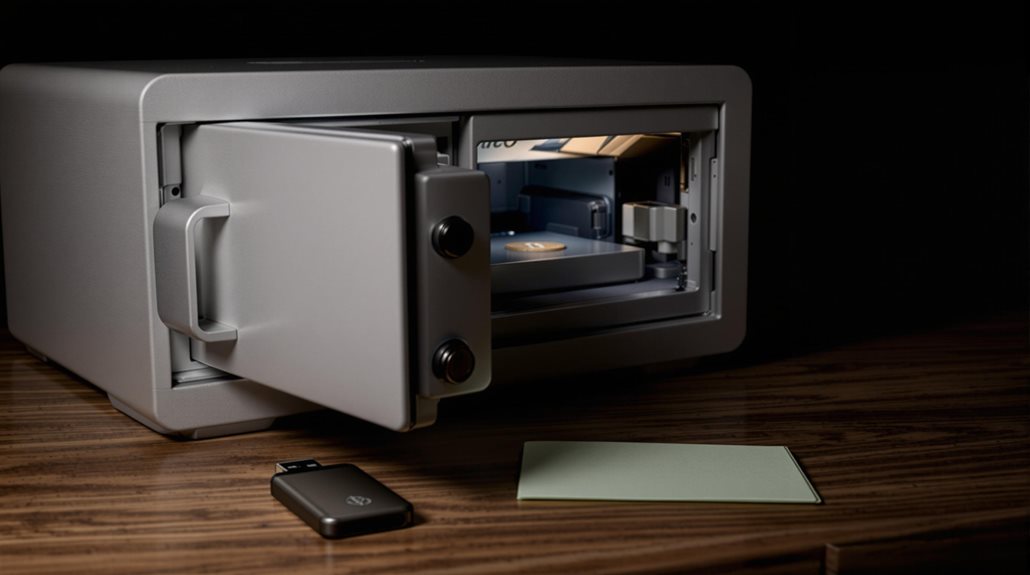Bitcoin holders can store their cryptocurrency using several secure methods. Hardware wallets like Ledger and Trezor provide offline storage for large amounts, while software wallets offer convenience for daily transactions. Paper wallets serve as a basic offline option by printing keys on paper. Multiple storage methods combined with two-factor authentication and regular backups help protect against loss or theft. Understanding each storage option's features helps users make informed security choices.

Storing Bitcoin safely has become increasingly significant as cryptocurrency gains mainstream adoption. There are several proven methods for keeping Bitcoin secure, each with its own benefits and drawbacks. The most secure option for storing large amounts of Bitcoin is a hardware wallet, which keeps private keys offline on a physical device. Cold storage solutions are crucial for protecting against exchange hacks and security breaches.
Hardware wallets like Ledger, Trezor, and KeepKey provide strong security features and require a physical connection to authorize transactions. While these devices typically cost between $40 and $200, they're considered worth the investment for serious Bitcoin holders who want maximum protection for their digital assets. Approximately 17% of Bitcoin has been permanently lost due to mishandled storage and forgotten keys. Regular antivirus scans are essential even for offline wallets to prevent potential malware infections.
For day-to-day transactions and smaller amounts, software wallets offer a more convenient solution. These wallets come in various forms, including mobile apps, desktop programs, and browser extensions. Popular options like Exodus, Trust Wallet, and MetaMask are either free or low-cost and support multiple cryptocurrencies. However, they're more vulnerable to online threats since they're connected to the internet. Unlike traditional wallets, these private keys don't store the actual cryptocurrency but rather the access codes to manage them on the blockchain.
Paper wallets represent the most basic form of offline storage. By printing public and private keys on paper, users can store their Bitcoin completely offline, making it immune to digital attacks. While this method is cost-effective, paper wallets can be damaged by water, fire, or simple wear and tear. They're also inconvenient for regular transactions, so they're not typically recommended for active Bitcoin users.
Many Bitcoin users employ multiple storage methods to balance security and convenience. This might mean keeping small amounts in a software wallet for regular transactions while storing larger holdings in a hardware wallet. Some users also maintain paper wallets as an additional backup method.
Security experts emphasize the significance of keeping wallet software and firmware up to date. They also recommend enabling two-factor authentication whenever it's available.
Backing up private keys and recovery phrases is vital, as losing these means losing access to the Bitcoin permanently. These backups should be stored in multiple secure locations to prevent loss from disasters or theft.
As the cryptocurrency market continues to evolve, storage solutions keep improving. The key is understanding that different storage methods serve different purposes. Hardware wallets provide top-level security for large amounts, software wallets offer convenience for regular use, and paper wallets can serve as a basic backup solution.
Whatever method users choose, regular maintenance and following security best practices remain fundamental for protecting Bitcoin holdings.
Frequently Asked Questions
What Happens to My Bitcoin if the Exchange Platform Suddenly Shuts Down?
When an exchange platform shuts down, customers' bitcoins can become frozen and inaccessible.
The exchange's assets typically get tied up in legal proceedings, and customers become unsecured creditors in bankruptcy cases.
It's not uncommon for people to lose their funds entirely or only get back a portion of their holdings.
While some users might recover funds through bankruptcy claims or class action lawsuits, there's no guarantee of getting everything back.
Can I Recover My Bitcoin if I Lose My Hardware Wallet?
Yes, Bitcoin can be recovered if someone loses their hardware wallet.
They'll need their seed phrase – a list of 12-24 words that acts like a master password. With this phrase, they can buy a new hardware wallet and restore their Bitcoin.
The seed phrase is the key to recovery, not the physical wallet itself. Without the seed phrase, the Bitcoin can't be recovered, even with a new device.
Are Paper Wallets Still Considered a Secure Storage Method in 2024?
Paper wallets aren't considered as secure as they once were in 2024.
While they're completely offline, they face several risks like physical damage, theft, and printing vulnerabilities.
The crypto community has largely moved away from paper wallets in favor of hardware wallets.
Paper wallets can still work for storing Bitcoin, but they're more prone to user error and require extreme care in creation and storage.
How Often Should I Update My Bitcoin Wallet's Security Features?
Bitcoin wallet users typically update their security features whenever new versions become available.
It's common to check for updates at least weekly. Studies show that regular updates reduce hack risks by 60-80%.
The crypto community considers immediate installation of security patches essential, as they fix vulnerabilities and add protection against new threats.
Most modern wallets offer automatic updates, which help users stay current with security improvements.
What's the Maximum Amount of Bitcoin I Should Keep in a Hot Wallet?
Most Bitcoin users keep only 5-10% of their total holdings in hot wallets. This amount typically covers day-to-day transactions and short-term trading needs.
It's common for active traders to store about 1-2 months' worth of trading funds in hot wallets. The remaining 90-95% usually goes into cold storage solutions like hardware wallets.
Hot wallet amounts vary based on each person's needs, trading frequency, and comfort level with online storage.





